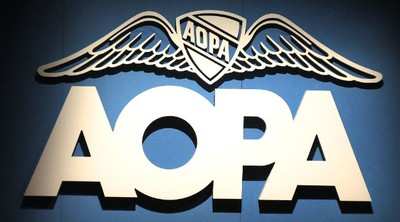Do We REALLY Have ALL The Facts?
News/Analysis By ANN Contributor, Bob Miller
Each year, the AOPA Air Safety Foundation publishes a
statistical report of general aviation accidents. This is called
the Nall Report. It's named after Joseph P. Nall, an NTSB Board
member who died as a passenger in an airplane crash in Caracas,
Venezuela, in 1989.

Regrettably, based upon the paucity of new information contained
in each annual Nall Report, I'm likely one of only a dozen or so
people who actually read the 2010 edition cover-to-cover. I did so
this year in the vain hope of discovering something other than the
positive spin on our chronic fatal accident rate that its editors
and statisticians so dutifully apply year after year. Instead, it
was the same findings, rationals, and defense of an industry that
should be ashamed of its abhorrent safety record. Thus, no
surprises were found.
If it is the GA industry's intent to convince the non-flying
community that general aviation is safer than it really is - and
that our safety record is improving with each passing year, the
NALL Report rates an A plus.
On the other hand, the Nall Report's usefulness in helping to
formulate improvements in the way we train pilots, in uncovering
the mysteries behind our chronic fatal accident rate, and in
providing guidance to us veteran pilots on how best to optimize our
proficiency, it deserves little more than a D minus.
The Faulty Denominator
Hold the e-mail. I'll admit that the problem is not entirely in
the hands of the Nall Report editors and statisticians. Much of the
problem lies in the inherent weaknesses of the data they use to
compile the report. The most serious offender in this regard is the
FAA's "estimate" of annual aircraft hours flown.

This "estimate" is derived from a simple FAA-administered survey
of a sampling of GA pilots - about one percent of the total pilot
population. Curiously, I suspect that only active pilots actually
complete and return these survey forms. The pilots who have
curtailed or stopped flying likely never return the survey
forms.
Given the fact that this "estimate" forms the basis of all
reported accident RATE information, we can reasonably conclude that
the NALL Report is little more than an "estimate" of what is
happening in the real world of general aviation. This make for a
nifty way to spin the data whichever way one likes.
Equally problematic is the fact that the "estimate" of annual
hours flown is non-aircraft type specific. For example, we really
have no clue whether single engine operations are actually more
risky than multi-engine operations. Nor do we have an objective
basis to determine if glass cockpits afford us any greater safety
advantage than steam-gauge aircraft.
Does anybody really know, based upon actual accident rate data
by aircraft type, if Cirrus SR22 aircraft are more prone to fatal
accidents than Cessna 206s? Does anybody really care? Those who pay
insurance premiums might like to know.
"One Size Fits All" Flight Training Curriculum
Since we lack any objectively derived accident rate data based
upon aircraft type, make, or model, those of us in the flight
training business are constrained to offer a "one size fits all"
training curriculum. On the other hand, if low wing singles are
more prone to fatal spin encounters than high wing aircraft, based
upon actual RATE data, then training curricula should be adjusted
accordingly.

Are we seeing more landing accidents in glass composite aircraft
like the Cessna Corvalis and Cirrus SR22 than we are in metal
aircraft? If so, let's tailor the training curriculum
accordingly.
Do flight schools using Diamond DA20 aircraft have a better
safety record, again based upon actual rate data, than schools
using Cessna 172s?
Curiously, we've been seeing a big spike in the number of fatal
accidents involving homebuilt aircraft. From this, can we conclude
that homebuilt aircraft are inherently more dangerous than
production aircraft? Perhaps, instead, there has been a huge
increase in the number homebuilt aircraft hours flown. This would
certainly spike the numbers.
Right now, of course, there is no way to correlate the number of
homebuilt aircraft accidents with the actual number of homebuilt
aircraft hours flown. Thus, any current criticism of the home
building industry is entirely without merit.
The Aging Fleet Dilemma
We're beginning to be increasingly concerned about the aging of
the GA fleet. Do aircraft with 7,000 or more hours total time
suffer a higher fatal accident rate than, say, aircraft with 3,000
or fewer hours total time? Right now, nobody knows for certain.
To be fair, we cannot, nor should we, lump all GA aircraft
types, makes, and models in this age-related safety determination.
If Beech builds a more durable aircraft than Piper or Cessna, the
accident rate data should bear that out. Similarly, insurance
premiums should reflect that finding.
Banish the nay-sayers
"Whoa," say the nay-sayers. "We can't possibly gather than kind
of data. The costs would be prohibitive. The burden on the industry
would be staggering. Besides, it's nobody's business how much I fly
my airplane."
Predictably, AOPA would be standing at the head of the line
protesting any such privacy infringement on its member pilots. The
halls of Congress would be blanketed with form letters of
opposition artfully crafted by AOPA for signature and mailing by
its 400,000 member pilots. In the end, another positive step
forward in improving our chronic fatal accident rated would be
successfully thwarted.

In truth, gathering objective annual hours flown by aircraft
type, make, and model would be a snap. Since every GA aircraft must
go through an annual inspection or, in the case of home built
aircraft, annual condition inspections, it would be a quick and
easy step to record and submit to the FAA the aircraft type, make,
model, year of manufacture, and number of hours each inspected
aircraft has flown in the previous 12 months (or whatever period
covered since the last inspection). Bingo, that's it.
Curiously, the federal budget required to implement this
procedure would likely be less than the money it spends sending out
and analyzing pilot surveys.
As for an infringement of pilot privacy, we pilots waive any
such right to privacy whenever we sign a medical history form each
time we see the aviation medical examiner. Recall, we report the
number of hours we flown in the past 90 days. We also waive such
right to privacy whenever we sign an application for a new pilot
rating or certificate.
It's Time We Get Real
We live in a brave new world. It's a world where fatal airplane
accidents should no longer be occurring. Sure, there will be the
occasional screw up or dumb pilot trick that results in a fatality.
Let's say that those type of accidents account for about 50 a year.
But what about the remaining 200 or so fatals each year? Why are
they occurring?

There is currently no way of knowing for certain what impact ANY
changes we make in the GA system has or will have on our fatal
accident rate. None, nothing, nada. We're only guessing - and that
ain't no way to run an airline.
So, nay-sayers, and that includes you, AOPA, let's get behind
this effort to objectively quantify our annual hours flown by
aircraft type, make and model. When you do so and this system is
finally implemented, the Nall Report will finally offer genuine
benefit to the industry. Until then, it's simply another way to
spend member pilot dollars in a totally non-effective way.
Flying has risks. Choose wisely.
 ANN's Daily Aero-Linx (04.15.24)
ANN's Daily Aero-Linx (04.15.24) Classic Aero-TV: 'No Other Options' -- The Israeli Air Force's Danny Shapira
Classic Aero-TV: 'No Other Options' -- The Israeli Air Force's Danny Shapira Aero-News: Quote of the Day (04.15.24)
Aero-News: Quote of the Day (04.15.24) Airborne 04.16.24: RV Update, Affordable Flying Expo, Diamond Lil
Airborne 04.16.24: RV Update, Affordable Flying Expo, Diamond Lil ANN's Daily Aero-Term (04.16.24): Chart Supplement US
ANN's Daily Aero-Term (04.16.24): Chart Supplement US







